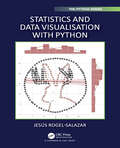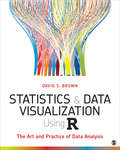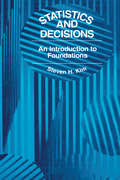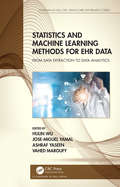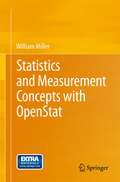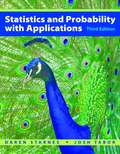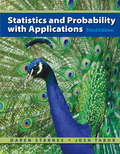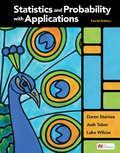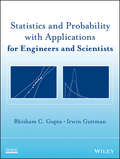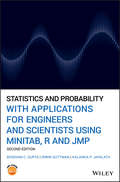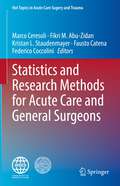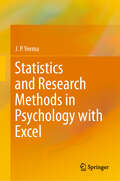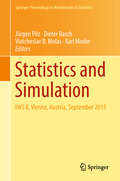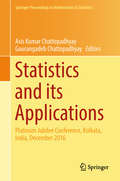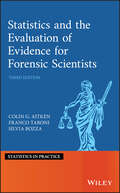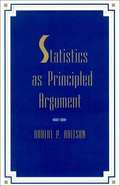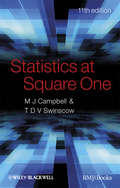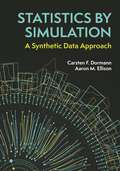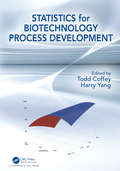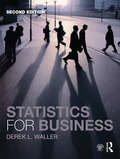- Table View
- List View
Statistics and Data Visualisation with Python (Chapman & Hall/CRC The Python Series)
by Jesus Rogel-SalazarThis book is intended to serve as a bridge in statistics for graduates and business practitioners interested in using their skills in the area of data science and analytics as well as statistical analysis in general. On the one hand, the book is intended to be a refresher for readers who have taken some courses in statistics, but who have not necessarily used it in their day-to-day work. On the other hand, the material can be suitable for readers interested in the subject as a first encounter with statistical work in Python. Statistics and Data Visualisation with Python aims to build statistical knowledge from the ground up by enabling the reader to understand the ideas behind inferential statistics and begin to formulate hypotheses that form the foundations for the applications and algorithms in statistical analysis, business analytics, machine learning, and applied machine learning. This book begins with the basics of programming in Python and data analysis, to help construct a solid basis in statistical methods and hypothesis testing, which are useful in many modern applications.
Statistics and Data Visualization Using R: The Art and Practice of Data Analysis
by David S. BrownDesigned to introduce students to quantitative methods in a way that can be applied to all kinds of data in all kinds of situations, Statistics and Data Visualization Using R: The Art and Practice of Data Analysis by David S. Brown teaches students statistics through charts, graphs, and displays of data that help students develop intuition around statistics as well as data visualization skills. By focusing on the visual nature of statistics instead of mathematical proofs and derivations, students can see the relationships between variables that are the foundation of quantitative analysis. Using the latest tools in R and R RStudio® for calculations and data visualization, students learn valuable skills they can take with them into a variety of future careers in the public sector, the private sector, or academia. Starting at the most basic introduction to data and going through most crucial statistical methods, this introductory textbook quickly gets students new to statistics up to speed running analyses and interpreting data from social science research.
Statistics and Data Visualization Using R: The Art and Practice of Data Analysis
by David S. BrownDesigned to introduce students to quantitative methods in a way that can be applied to all kinds of data in all kinds of situations, Statistics and Data Visualization Using R: The Art and Practice of Data Analysis by David S. Brown teaches students statistics through charts, graphs, and displays of data that help students develop intuition around statistics as well as data visualization skills. By focusing on the visual nature of statistics instead of mathematical proofs and derivations, students can see the relationships between variables that are the foundation of quantitative analysis. Using the latest tools in R and R RStudio® for calculations and data visualization, students learn valuable skills they can take with them into a variety of future careers in the public sector, the private sector, or academia. Starting at the most basic introduction to data and going through most crucial statistical methods, this introductory textbook quickly gets students new to statistics up to speed running analyses and interpreting data from social science research.
Statistics and Decisions: An Introduction to Foundations
by S. H. KimThis book provides the necessary prerequisites in probability and statistics as well as the key ideas in decision theory. It is helpful to students and practitioners who desire to apply decision-theoretic thinking to their own work.
Statistics and Health Care Fraud: How to Save Billions (ASA-CRC Series on Statistical Reasoning in Science and Society)
by Tahir EkinStatistics and Health Care Fraud: How to Save Billions helps the public to become more informed citizens through discussions of real world health care examples and fraud assessment applications. The author presents statistical and analytical methods used in health care fraud audits without requiring any mathematical background. The public suffers from health care overpayments either directly as patients or indirectly as taxpayers, and fraud analytics provides ways to handle the large size and complexity of these claims. The book starts with a brief overview of global healthcare systems such as U.S. Medicare. This is followed by a discussion of medical overpayments and assessment initiatives using a variety of real world examples. The book covers subjects as: • Description and visualization of medical claims data • Prediction of fraudulent transactions • Detection of excessive billings • Revealing new fraud patterns • Challenges and opportunities with health care fraud analytics Dr. Tahir Ekin is the Brandon Dee Roberts Associate Professor of Quantitative Methods in McCoy College of Business, Texas State University. His previous work experience includes a working as a statistician on health care fraud detection. His scholarly work on health care fraud has been published in a variety of academic journals including International Statistical Review, The American Statistician, and Applied Stochastic Models in Business and Industry. He is a recipient of the Texas State University 2018 Presidential Distinction Award in Scholar Activities and the ASA/NISS y-Bis 2016 Best Paper Awards. He has developed and taught courses in the areas of business statistics, optimization, data mining and analytics. Dr. Ekin also serves as Vice President of the International Society for Business and Industrial Statistics.
Statistics and Machine Learning Methods for EHR Data: From Data Extraction to Data Analytics (Chapman & Hall/CRC Healthcare Informatics Series)
by Hulin Wu Jose-Miguel Yamal Ashraf Yaseen Vahed MaroufyThe use of Electronic Health Records (EHR)/Electronic Medical Records (EMR) data is becoming more prevalent for research. However, analysis of this type of data has many unique complications due to how they are collected, processed and types of questions that can be answered. This book covers many important topics related to using EHR/EMR data for research including data extraction, cleaning, processing, analysis, inference, and predictions based on many years of practical experience of the authors. The book carefully evaluates and compares the standard statistical models and approaches with those of machine learning and deep learning methods and reports the unbiased comparison results for these methods in predicting clinical outcomes based on the EHR data. Key Features: Written based on hands-on experience of contributors from multidisciplinary EHR research projects, which include methods and approaches from statistics, computing, informatics, data science and clinical/epidemiological domains. Documents the detailed experience on EHR data extraction, cleaning and preparation Provides a broad view of statistical approaches and machine learning prediction models to deal with the challenges and limitations of EHR data. Considers the complete cycle of EHR data analysis. The use of EHR/EMR analysis requires close collaborations between statisticians, informaticians, data scientists and clinical/epidemiological investigators. This book reflects that multidisciplinary perspective.
Statistics and Measurement Concepts with OpenStat
by William MillerThis reference manual for the OpenStat software, an open-source software developed by William Miller, covers a broad spectrum of statistical methods and techniques. A unique feature is its compatibility with many other statistical programs. OpenStat users are researchers and students in the social sciences, education, or psychology, who benefit from the hands on approach to Statistics. During and upon completion of courses in Statistics or measurement, students and future researchers need a low cost computer program available to them, and OpenStat fills this void. The software is used in Statistics courses around the world with over 50,000 downloads per year. The manual covers all functions of the OpenStat software, including measurement, ANOVAS, regression analyses, simulations, product-moment and partial correlations, and logistic regression. The manual is an important learning tool that explains the Statistics behind the many analyses possible with the program and demonstrates these analyses.
Statistics and Probability Theory
by Michael Havbro FaberThis book provides the reader with the basic skills and tools of statistics and probability in the context of engineering modeling and analysis. The emphasis is on the application and the reasoning behind the application of these skills and tools for the purpose of enhancing decision making in engineering. The purpose of the book is to ensure that the reader will acquire the required theoretical basis and technical skills such as to feel comfortable with the theory of basic statistics and probability. Moreover, in this book, as opposed to many standard books on the same subject, the perspective is to focus on the use of the theory for the purpose of engineering model building and decision making. This work is suitable for readers with little or no prior knowledge on the subject of statistics and probability.
Statistics and Probability with Applications (High School)
by Josh Tabor Daren StarnesStatistics and Probability with Applications, Third Edition is the only introductory statistics text written by high school teachers for high school teachers and students. Daren Starnes, Josh Tabor, and the extended team of contributors bring their in-depth understanding of statistics and the challenges faced by high school students and teachers to development of the text and its accompanying suite of print and interactive resources for learning and instruction. A complete re-envisioning of the authors’ Statistics Through Applications, this new text covers the core content for the course in a series of brief, manageable lessons, making it easy for students and teachers to stay on pace. Throughout, new pedagogical tools and lively real-life examples help captivate students and prepare them to use statistics in college courses and in any career.
Statistics and Probability with Applications (High School)
by Josh Tabor Daren Starnes Luke WilcoxThis engaging and modern introduction to statistics helps prepare students for success in this course and in life. Structured into bite-sized lessons with many integrated activities to get students “doing statistics” from the start, this program helps students understand the “why” and “how” of statistics.
Statistics and Probability with Applications for Engineers and Scientists
by Bhisham C. Gupta Irwin GuttmanIntroducing the tools of statistics and probability from the ground upAn understanding of statistical tools is essential for engineers and scientists who often need to deal with data analysis over the course of their work. Statistics and Probability with Applications for Engineers and Scientists walks readers through a wide range of popular statistical techniques, explaining step-by-step how to generate, analyze, and interpret data for diverse applications in engineering and the natural sciences.Unique among books of this kind, Statistics and Probability with Applications for Engineers and Scientists covers descriptive statistics first, then goes on to discuss the fundamentals of probability theory. Along with case studies, examples, and real-world data sets, the book incorporates clear instructions on how to use the statistical packages Minitab® and Microsoft® Office Excel® to analyze various data sets. The book also features:* Detailed discussions on sampling distributions, statistical estimation of population parameters, hypothesis testing, reliability theory, statistical quality control including Phase I and Phase II control charts, and process capability indices* A clear presentation of nonparametric methods and simple and multiple linear regression methods, as well as a brief discussion on logistic regression method* Comprehensive guidance on the design of experiments, including randomized block designs, one- and two-way layout designs, Latin square designs, random effects and mixed effects models, factorial and fractional factorial designs, and response surface methodology* A companion website containing data sets for Minitab and Microsoft Office Excel, as well as JMP ® routines and resultsAssuming no background in probability and statistics, Statistics and Probability with Applications for Engineers and Scientists features a unique, yet tried-and-true, approach that is ideal for all undergraduate students as well as statistical practitioners who analyze and illustrate real-world data in engineering and the natural sciences.
Statistics and Probability with Applications for Engineers and Scientists Using MINITAB, R and JMP
by Bhisham C. Gupta Irwin Guttman Kalanka P. JayalathIntroduces basic concepts in probability and statistics to data science students, as well as engineers and scientists Aimed at undergraduate/graduate-level engineering and natural science students, this timely, fully updated edition of a popular book on statistics and probability shows how real-world problems can be solved using statistical concepts. It removes Excel exhibits and replaces them with R software throughout, and updates both MINITAB and JMP software instructions and content. A new chapter discussing data mining—including big data, classification, machine learning, and visualization—is featured. Another new chapter covers cluster analysis methodologies in hierarchical, nonhierarchical, and model based clustering. The book also offers a chapter on Response Surfaces that previously appeared on the book’s companion website. Statistics and Probability with Applications for Engineers and Scientists using MINITAB, R and JMP, Second Edition is broken into two parts. Part I covers topics such as: describing data graphically and numerically, elements of probability, discrete and continuous random variables and their probability distributions, distribution functions of random variables, sampling distributions, estimation of population parameters and hypothesis testing. Part II covers: elements of reliability theory, data mining, cluster analysis, analysis of categorical data, nonparametric tests, simple and multiple linear regression analysis, analysis of variance, factorial designs, response surfaces, and statistical quality control (SQC) including phase I and phase II control charts. The appendices contain statistical tables and charts and answers to selected problems. Features two new chapters—one on Data Mining and another on Cluster Analysis Now contains R exhibits including code, graphical display, and some results MINITAB and JMP have been updated to their latest versions Emphasizes the p-value approach and includes related practical interpretations Offers a more applied statistical focus, and features modified examples to better exhibit statistical concepts Supplemented with an Instructor's-only solutions manual on a book’s companion website Statistics and Probability with Applications for Engineers and Scientists using MINITAB, R and JMP is an excellent text for graduate level data science students, and engineers and scientists. It is also an ideal introduction to applied statistics and probability for undergraduate students in engineering and the natural sciences.
Statistics and Research Methods for Acute Care and General Surgeons (Hot Topics in Acute Care Surgery and Trauma)
by Fausto Catena Federico Coccolini Marco Ceresoli Fikri M. Abu-Zidan Kristan L. StaudenmayerThe main aim of this book is to offer an easy tool to read a scientific article with greater awareness, to understand and evaluate it more thoroughly, and to better plan research. Today, in the era of evidence-based medicine, both research and daily patient-focused clinical practice are no longer possible without a thorough knowledge of the literature and its continuous updates.Written by surgeons for surgeons, this practical book makes the basic concept of statistics and research methodology easy to understand and apply for young surgeons and researchers, students and residents.
Statistics and Research Methods in Psychology with Excel
by J.P. VermaThis book, specifically developed for students of psychology, covers a wide range of topics in statistics and research designs taught in psychology, in particular, and other disciplines like management, sociology, education, home science, and nutrition, in general, in most universities. It explains how to use Excel to analyze research data by elaborating statistical concepts. Each chapter contains sections like “Check you Computing skill” and “Check your Statistical Concepts” to enable students to assess their knowledge in a graded manner. The book addresses one of the major challenges in psychology research, viz., how to measure subjective phenomenon like attitude, desire, and preferences of an individual. Separate emphasis has been given to the measurement techniques which are essential tools to assess these subjective parameters in numerical form, required for statistical analysis to draw meaningful conclusions. The book is equally helpful to students of humanities, life sciences and other applied areas. Consisting of 14 chapters, the book covers all relevant topics of statistics and research designs which are important for students to plan and complete their research work.
Statistics and Simulation: Iws 8, Vienna, Austria, September 2015 (Springer Proceedings in Mathematics & Statistics #231)
by Dieter Rasch Jürgen Pilz Viatcheslav B. Melas Karl ModerThis volume features original contributions and invited review articles on mathematical statistics, statistical simulation and experimental design. The selected peer-reviewed contributions originate from the 8th International Workshop on Simulation held in Vienna in 2015. The book is intended for mathematical statisticians, Ph.D. students and statisticians working in medicine, engineering, pharmacy, psychology, agriculture and other related fields.The International Workshops on Simulation are devoted to statistical techniques in stochastic simulation, data collection, design of scientific experiments and studies representing broad areas of interest. The first 6 workshops took place in St. Petersburg, Russia, in 1994 – 2009 and the 7th workshop was held in Rimini, Italy, in 2013.
Statistics and its Applications: Platinum Jubilee Conference, Kolkata, India, December 2016 (Springer Proceedings in Mathematics & Statistics #244)
by Asis Kumar Chattopadhyay Gaurangadeb ChattopadhyayThis book discusses recent developments and the latest research in statistics and its applications, primarily in agriculture and industry, survey sampling and biostatistics, gathering articles on a wide variety of topics. Written by leading academics, scientists, researchers and scholars from around the globe to mark the platinum jubilee of the Department of Statistics, University of Calcutta in 2016, the book is a valuable resource for statisticians, aspiring researchers and professionals across educational levels and disciplines.
Statistics and the Evaluation of Evidence for Forensic Scientists (Statistics in Practice)
by Colin Aitken Silvia Bozza Franco TaroniThe leading resource in the statistical evaluation and interpretation of forensic evidence The third edition of Statistics and the Evaluation of Evidence for Forensic Scientists is fully updated to provide the latest research and developments in the use of statistical techniques to evaluate and interpret evidence. Courts are increasingly aware of the importance of proper evidence assessment when there is an element of uncertainty. Because of the increasing availability of data, the role of statistical and probabilistic reasoning is gaining a higher profile in criminal cases. That’s why lawyers, forensic scientists, graduate students, and researchers will find this book an essential resource, one which explores how forensic evidence can be evaluated and interpreted statistically. It’s written as an accessible source of information for all those with an interest in the evaluation and interpretation of forensic scientific evidence. Discusses the entire chain of reasoning–from evidence pre-assessment to court presentation; Includes material for the understanding of evidence interpretation for single and multiple trace evidence; Provides real examples and data for improved understanding. Since the first edition of this book was published in 1995, this respected series has remained a leading resource in the statistical evaluation of forensic evidence. It shares knowledge from authors in the fields of statistics and forensic science who are international experts in the area of evidence evaluation and interpretation. This book helps people to deal with uncertainty related to scientific evidence and propositions. It introduces a method of reasoning that shows how to update beliefs coherently and to act rationally. In this edition, readers can find new information on the topics of elicitation, subjective probabilities, decision analysis, and cognitive bias, all discussed in a Bayesian framework.
Statistics as Principled Argument
by Robert P. AbelsonIn this illuminating volume, Robert P. Abelson delves into the too-often dismissed problems of interpreting quantitative data and then presenting them in the context of a coherent story about one's research. Unlike too many books on statistics, this is a remarkably engaging read, filled with fascinating real-life (and real-research) examples rather than with recipes for analysis. It will be of true interest and lasting value to beginning graduate students and seasoned researchers alike. The focus of the book is that the purpose of statistics is to organize a useful argument from quantitative evidence, using a form of principled rhetoric. Five criteria, described by the acronym MAGIC (magnitude, articulation, generality, interestingness, and credibility) are proposed as crucial features of a persuasive, principled argument. Particular statistical methods are discussed, with minimum use of formulas and heavy data sets. The ideas throughout the book revolve around elementary probability theory, tests, and simple issues of research design. It is therefore assumed that the reader has already had some access to elementary statistics. Many examples are included to explain the connection of statistics to substantive claims about real phenomena.
Statistics at Square One
by Michael J. Campbell T. D. SwinscowThe new edition of this international bestseller continues to throw light on the world of statistics for health care professionals and medical students.Revised throughout, the 11th edition features new material in the areas ofrelative risk, absolute risk and numbers needed to treatdiagnostic tests, sensitivity, specificity, ROC curvesfree statistical softwareThe popular self-testing exercises at the end of every chapter are strengthened by the addition of new sections on reading and reporting statistics and formula appreciation.
Statistics by Simulation: A Synthetic Data Approach
by Aaron M. Ellison Carsten F. DormannAn accessible guide to understanding statistics using simulations, with examples from a range of scientific disciplinesReal-world challenges such as small sample sizes, skewed distributions of data, biased sampling designs, and more predictors than data points are pushing the limits of classical statistical analysis. This textbook provides a new tool for the statistical toolkit: data simulations. It shows that using simulation and data-generating models is an excellent way to validate statistical reasoning and to augment study design and statistical analysis with planning and visualization. Although data simulations are not new to professional statisticians, Statistics by Simulation makes the approach accessible to a broader audience, with examples from many fields. It introduces the reasoning behind data simulation and then shows how to apply it in planning experiments or observational studies, developing analytical workflows, deploying model diagnostics, and developing new indices and statistical methods.• Covers all steps of statistical practice, from planning projects to post-hoc analysis and model checking• Provides examples from disciplines including sociology, psychology, ecology, economics, physics, and medicine• Includes R code for all examples, with data and code freely available online• Offers bullet-point outlines and summaries of each chapter• Minimizes the use of jargon and requires only basic statistical background and skills
Statistics for Anthropology
by Lorena MadrigalAnthropology as a discipline is rapidly becoming more quantitative, and anthropology students are now required to develop sophisticated statistical skills. This book provides students of anthropology with a clear, step-by-step guide to univariate statistical methods, demystifying the aspects that are often seen as difficult or impenetrable. Explaining the central role of statistical methods in anthropology and using only anthropological examples, the book provides a solid footing in statistical techniques. Beginning with basic descriptive statistics, this new edition also covers more advanced methods such as analyses of frequencies and variance, simple and multiple regression analysis with dummy and continuous variables. It addresses commonly encountered problems such as small samples and non-normality. Each statistical technique is accompanied by clearly worked examples and the chapters end with practice problem sets. Many of the datasets are available for download at www.cambridge.org/9780521147088.
Statistics for Archaeologists
by Robert D. DrennanIn the decade since its publication, the first edition of Statistics for Archaeologists has become a staple in the classroom. Taking a jargon-free approach, this teaching tool introduces the basic principles of statistics to archaeologists. The author covers the necessary techniques for analyzing data collected in the field and laboratory as well as for evaluating the significance of the relationships between variables. In addition, chapters discuss the special concerns of working with samples. This well-illustrated guide features several practice problems making it an ideal text for students in archaeology and anthropology. Using feedback from students and teachers who have been using the first edition, as well as another ten years of personal experience with the text, the author has provided an updated and revised second edition with a number of important changes. New topics covered include: -Proportions and Densities -Error Ranges for Medians -Resampling Approaches -Residuals from Regression -Point Sampling -Multivariate Analysis -Similarity Measures -Multidimensional Scaling -Principal Components Analysis -Cluster Analysis Those already familiar with the clear and useful format of Statistics for Archaeologists will find this new edition a welcome update, and the new sections will make this seminal textbook an indispensible resource for a whole new group of students, professors, and practitioners.
Statistics for Biotechnology Process Development
by Harry Yang Todd CoffeyWritten specifically for biotechnology scientists, engineers, and quality professionals, this book describes and demonstrates the proper application of statistical methods throughout Chemistry, Manufacturing, and Controls (CMC). Filled with case studies, examples, and easy-to-follow explanations of how to perform statistics in modern software, it is the first book on CMC statistics written primarily for practitioners. While statisticians will also benefit from this book, it is written particularly for industry professionals who don’t have access to a CMC statistician or who want to be more independent in the design and analysis of their experiments. Provides an introduction to the statistical concepts important in the biotechnology industry Focuses on concepts with theoretical details kept to a minimum Includes lots of real examples and case studies to illustrate the methods Uses JMP software for implementation of the methods Offers a text suitable for scientists in the industry with some quantitative training Written and edited by seasoned veterans of the biotechnology industry, this book will prove useful to a wide variety of biotechnology professionals. The book brings together individual chapters that showcase the use of statistics in the most salient areas of CMC.
Statistics for Business
by Derek L. WallerStatistics for Business explains the fundamentals of statistical analysis in a lucid, pragmatic way. A thorough knowledge of statistics is essential for decision making in all corners of business and management. By collecting, organizing and analyzing statistical data you can express what you know, benchmark your current situation, and estimate future outcomes. Based entirely on Microsoft Excel, this book covers a spectrum of statistic fundamentals from basic principles, to probability, sampling, hypothesis testing, forecasting, statistical process control and six-sigma management. This second edition is packed with features to aid understanding and help ensure that every aspect of your knowledge of statistics is applicable to practice, including: Icebreakers introducing each chapter that relate statistics to the real world, drawn from management and hospitality situations Detailed worked examples in each chapter Over 140 case-exercises complete with objective, situation, requirements, and answers A complete glossary of key terminology and formulas, mathematical relationships, and Excel relationships and functions A brand new companion website containing slides, worked-out-solutions to the case-exercises, and a test bank With a clear and accessible style this book makes statistics easier to understand. It is ideal for business, management, tourism and hospitality students who want to learn how to apply statistics to the real world.
